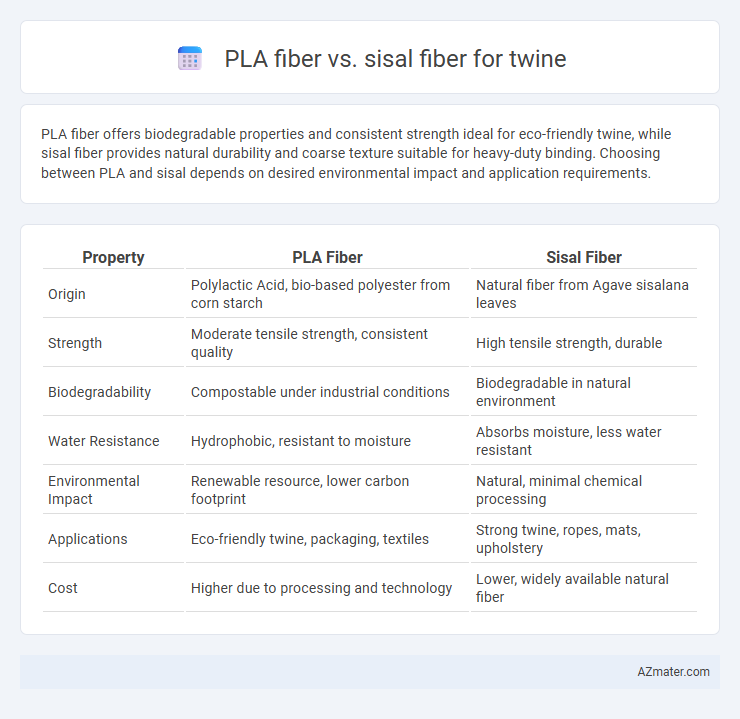PLA fiber offers biodegradable properties and consistent strength ideal for eco-friendly twine, while sisal fiber provides natural durability and coarse texture suitable for heavy-duty binding. Choosing between PLA and sisal depends on desired environmental impact and application requirements.
Table of Comparison
| Property | PLA Fiber | Sisal Fiber |
|---|---|---|
| Origin | Polylactic Acid, bio-based polyester from corn starch | Natural fiber from Agave sisalana leaves |
| Strength | Moderate tensile strength, consistent quality | High tensile strength, durable |
| Biodegradability | Compostable under industrial conditions | Biodegradable in natural environment |
| Water Resistance | Hydrophobic, resistant to moisture | Absorbs moisture, less water resistant |
| Environmental Impact | Renewable resource, lower carbon footprint | Natural, minimal chemical processing |
| Applications | Eco-friendly twine, packaging, textiles | Strong twine, ropes, mats, upholstery |
| Cost | Higher due to processing and technology | Lower, widely available natural fiber |
Introduction to PLA Fiber and Sisal Fiber
PLA fiber, derived from renewable resources like corn starch, offers biodegradability and high tensile strength, making it a sustainable choice for twine production. Sisal fiber, extracted from the leaves of the Agave sisalana plant, is valued for its natural durability, resistance to moisture, and coarse texture, ideal for heavy-duty twine applications. Both fibers present eco-friendly alternatives, with PLA excelling in compostability and sisal in rugged outdoor performance.
Origin and Production Process
PLA fiber, derived from fermented plant starch such as corn or sugarcane, undergoes a bio-polymerization process to create a biodegradable polyester. Sisal fiber originates from the leaves of the Agave sisalana plant, harvested by decorticating the leaves and mechanically scraping out the fibers. The production of PLA fiber is more industrial and chemically intensive, while sisal fiber production remains largely traditional and manual, emphasizing sustainability and minimal processing.
Physical and Mechanical Properties
PLA fiber exhibits higher tensile strength and greater elasticity compared to sisal fiber, making it more resistant to breakage under stress. Sisal fiber, derived from natural agave leaves, offers superior abrasion resistance and moisture absorption but has lower elongation at break. The lightweight nature and biodegradability of PLA fiber further enhance its performance in twine applications, while sisal's coarse texture provides better grip but lower overall mechanical durability.
Environmental Impact and Sustainability
PLA fiber, derived from renewable resources like corn starch, offers significant environmental benefits due to its biodegradability and compostability, reducing plastic waste in soil and water systems. In contrast, sisal fiber, sourced from the Agave plant, is a natural and renewable fiber known for its low environmental footprint, as it requires minimal pesticides and water during cultivation and is fully biodegradable. Both fibers provide sustainable alternatives for twine production, but PLA's industrial composting requirement versus sisal's natural degradation highlight key differences in end-of-life environmental impact.
Biodegradability and Compostability
PLA fiber, derived from renewable resources like cornstarch, is biodegradable under industrial composting conditions, breaking down into water and carbon dioxide within months, making it suitable for eco-friendly twine applications. Sisal fiber, a natural vegetable fiber extracted from the agave plant, is inherently biodegradable and compostable in typical soil environments, degrading fully over a period of 6 to 12 months due to microbial activity. While PLA requires specific industrial composting facilities for optimal breakdown, sisal twine offers more straightforward home compostability and soil integration, enhancing its environmental appeal for sustainable packaging and gardening uses.
Strength and Durability Comparison
PLA fiber offers moderate tensile strength but tends to degrade faster under UV exposure compared to sisal fiber, which boasts high tensile strength and excellent resistance to abrasion. Sisal fiber's durability in outdoor conditions and moisture resistance outperforms PLA, making it more suitable for heavy-duty twine applications. While PLA twine is biodegradable and environmentally friendly, sisal fiber provides superior long-term strength and resilience in demanding environments.
Cost and Availability for Twine
PLA fiber for twine offers moderate cost efficiency with increasing availability due to growing bioplastic production, making it a viable eco-friendly alternative. Sisal fiber remains more cost-effective and widely accessible in tropical regions, supported by established agricultural supply chains. Market trends indicate rising PLA fiber prices driven by production scale, while sisal benefits from consistent harvest cycles and local sourcing.
Performance in Various Applications
PLA fiber offers superior tensile strength and biodegradability, making it ideal for eco-friendly twine used in agriculture and packaging. Sisal fiber provides excellent abrasion resistance and natural moisture-wicking properties, which enhances its durability in outdoor and marine applications. Both fibers perform well in specific environments, with PLA excelling in compostable uses and sisal thriving in durability-focused tasks.
Market Trends and Consumer Preferences
PLA fiber twine is gaining traction in sustainable packaging markets due to its biodegradability and renewable sourcing, appealing to eco-conscious consumers. Sisal fiber twine continues to hold strong in traditional agricultural and gardening sectors, prized for its natural strength and durability. Market trends indicate a growing consumer preference for PLA fiber in urban and environmentally-driven markets, while sisal maintains steady demand in rural and industrial applications.
Conclusion: Choosing the Right Fiber for Twine
PLA fiber offers biodegradability and consistent quality ideal for eco-friendly twine applications, while sisal fiber provides superior strength and natural abrasion resistance suited for heavy-duty uses. Selecting the right fiber depends on balancing environmental impact with performance needs, where PLA serves sustainable, lightweight tasks and sisal excels in durability-demanding contexts. Considering factors like tensile strength, biodegradability, and cost efficiency ensures optimized twine performance tailored to specific industrial or agricultural requirements.

Infographic: PLA fiber vs Sisal fiber for Twine
 azmater.com
azmater.com